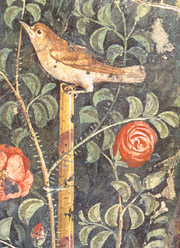
THE GARDENS OF POMPEII
The internal areas designated as gardens occupied a prime place in the Pompeiian house, and developed continuously during all periods of the city’s evolution. In the older dwellings, built in the third and fourth centuries B.C., the open space was reserved for growing fruit and vegetables, necessary produce for day-to-day life. In the centuries that followed, it was transformed into the viridarium (garden), with an essentially ornamental character, which eventually became the focal point of the house with the creation of the columned portico (peristilium or peristyle). Where there was not sufficient space for a complete peristilium, the private side of the portico had walls decorated with pictures of natural scenes, often framed by false colonnades to give the illusion of enlarging the actual dimensions of the green space. Hunting scenes, fights between wild animals and exotic landscapes also appeared, expanding the limited domestic dimension into an apparently unconfined natural space.
The architectonic design of the garden was completed by the widespread use of sculptures, decorative masks, oscillae (large hanging discs which oscillated in the wind), ponds and fountains with water games. Pollens, seeds, roots and the remains of carbonised fruit help us to understand which kinds of plants were cultivated; those which filled the gardens were not only ornamental such as oleanders, hedges and box-trees, but many were also used for cosmetic and medicinal purposes in everyday life. Pomegranates, figs, vines, cherries and a few rare limes often shadowed the triclinia during the hot summer days. A short walk through the gardens of Pompeii, recently restored, can be made by visiting some of the houses in which there is a good view of the viridaria.






